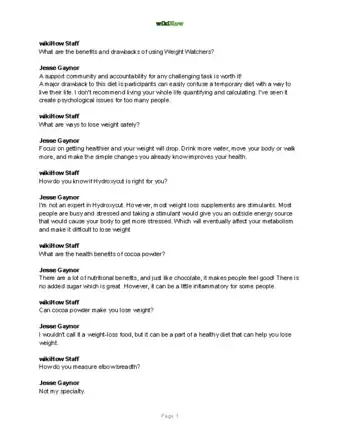This article was co-authored by Jesse Gaynor and by wikiHow staff writer, Hannah Madden. Jesse Gaynor is a Fitness and Health Trainer and the Owner of Jesse Gaynor Fitness & Wellness, which is based in the Los Angeles Metropolitan Area. With over 15 years of experience, he specializes in personal training, nutrition, and pain and injury recovery. He earned a Bachelor’s degree in Kinesiology and Exercise Science and an Associate’s degree in Psychology from The University of Southern California.
This article has been viewed 41,908 times.
Weight Watchers now has 3 different food plans to choose from: the green plan, the blue plan, and the purple plan. While they all follow the same basic formula of tracking your food intake throughout the day, they do offer slightly different SmartPoints and ZeroPoint foods. You can take the assessment on the MyWW app to find the plan right for you, or you can pick one based on the foods you already know and love.
Steps
The Green Plan
-
1Try the green plan for more SmartPoints and fewer ZeroPoints. ZeroPoint foods are ones that you don’t have to input into the tracker, so they don’t count toward your daily or weekly intake. SmartPoints are points you use for any food outside of your ZeroPoints list. The green plan has the least amount of ZeroPoints, meaning there aren’t as many foods you can build around that don’t count toward your weekly intake. It’s great if you’d like to stick to a specific meal plan with fewer options for snacking throughout the day.
- The green plan offers 100 ZeroPoint foods.
-
2Pick the green plan if you like fruits and vegetables. On the green plan, the only ZeroPoint foods you can have are fruits and non-starchy vegetables. All other foods will have to be reported as SmartPoints in your tracking app.
- Apples, bananas, pumpkin, pea shoots, radishes, mangoes, and honeydew melons are just some of the ZeroPoint foods offered on the green plan.
- The green plan does not include eggs or chicken breast like the blue and purple plans do.
Advertisement -
3Choose a different plan if you don’t like tracking your meals. Since this plan is structured around SmartPoints, you’ll be inputting almost everything you eat. If you struggle to remember what you ate / how much or you feel like it’s too similar to calorie counting, the blue or purple plan may be better for you.
- Inputting your meals every time you eat can actually be a bonus for holding yourself accountable. If you feel like you might like the structure, try out the green plan for yourself.
The Blue Plan
-
1Go for the blue plan for equal SmartPoints and ZeroPoints. SmartPoints are the points that you have to track when you eat foods that aren’t super healthy. ZeroPoints foods are ones that you don’t have to input because of their high nutritional value. The blue plan used to be called the WW Freestyle plan, and you may be on it already. It has an equal amount of SmartPoints (food that you count toward your weekly intake) and ZeroPoints (food that you don’t count toward your weekly intake).
- The amount of SmartPoints you get on your plan is unique to you based on your personal assessment.
- You’ll get over 200 ZeroPoint foods.
-
2Try the blue plan if you want to add starchy vegetables to your diet. The blue plan is a little more comprehensive in what it offers for ZeroPoint foods. Starchy vegetables, poultry, eggs, legumes, and plain yogurt are all okay to eat without spending your SmartPoints.[1]
- Since you’ll have an equal amount of SmartPoints and ZeroPoints, you can balance out your diet easily every day.
- For the full list of ZeroPoint foods on the blue plan, visit https://www.weightwatchers.com/us/sites/default/files/myww-blue.pdf.
-
3Avoid the blue plan if you don't want limited ZeroPoint foods. Since this plan has equal amounts of ZeroPoints and SmartPoints, it can be tough to limit yourself every time you plan a meal. If you’ve struggled in the past with overeating or you like the structure of the SmartPoints, the blue plan may not be for you.[2]
- While ZeroPoint foods are generally healthy, you can still overeat.
The Purple Plan
-
1Do the purple plan for more ZeroPoints and fewer SmartPoints. ZeroPoint foods are ones that you can eat without keeping track of in your tracker app. SmartPoints are the points you use for any foods that aren’t on the ZeroPoints list. If you love building your menu around foods that don’t count toward your weekly intake, the purple plan is for you. This plan has the most amount of ZeroPoints and the least amount of SmartPoints, meaning you’ll mostly be eating foods that don’t count toward your weekly intake.[3]
- The purple plan has over 300 ZeroPoint foods.
-
2Try the purple plan to incorporate pasta into your meals. The purple plan lets you have pasta, potatoes, rice, oats, and other grains without spending your SmartPoints. Since you have so many ZeroPoint foods, the majority of your plan will be spent on the ZeroPoints, not the SmartPoints.[4]
- Shrimp fried rice, italian sausage with pasta, omelettes, and muffins are all part of the meal suggestions under the purple plan.
- To check out recipe suggestions and the full list of ZeroPoint foods on the purple plan, visit https://www.weightwatchers.com/us/sites/default/files/myww-purple.pdf.
-
3Focus on plant proteins with the purple plan. Quinoa, sweet potatoes, oats, and chickpeas are all featured heavily on the purple plan. If you don’t mind boosting your meals with one of these items, try out the purple plan for yourself.[5]
- You can make snacks, sides, desserts, and whole meals out of these superfoods.
-
4Avoid the purple plan if you often eat starchy foods. With foods like pasta, rice, and potatoes included in the ZeroPoint foods, it can be easy to eat a lot of them. If starchy foods are your favorite or you’ve struggled with overeating in the past, the purple plan may not be for you.[6]
- If you’re good at self-regulation or you want to get better at it, the purple plan can help with that. One of the biggest benefits of WW is the support community and the accountability it creates. This plan makes you hold yourself accountable rather than inputting and tracking all of your meals.
Using Weight Watchers Effectively
-
1Take the MyWW assessment to find the right plan for you. If you’re new to Weight Watchers, you might not have taken the personal assessment yet. Download the MyWW app on your smartphone or tablet, then take the personal quiz to find out which plan is the best for you. Fill out your eating habits, your health background, and what you like to eat throughout the week.
- If you’ve had an account for a while, you’ve probably already taken this assessment, and you don’t need to take it again.
-
2Try your plan for 2 weeks before deciding to switch. If you want to try out a couple different plans before committing, give them 2 weeks before deciding to switch over. That’s about how long it will take to see if the new plan fits your lifestyle and dietary needs, so give it a little bit of time!
- You can easily switch your plan on the MyWW app or website.
-
3Connect with members on your same plan on the MyWW app. When you choose a color to stick with, you can connect with other Weight Watchers members to see how they’re doing on your same plan. Head to the app and click on the “Connect” tab at the bottom of the screen. From there, you can choose the community you’d like to participate in based on which plan you’re doing right now.[7]
- You can share tips and tricks, triumphs, or setbacks, as well as ask others for advice, if you need to.
-
4Track your daily and weekly SmartPoints. On each plan, you’ll have a daily amount of SmartPoints that roll over throughout the week. On the app, you can keep track of how many SmartPoints you have left for the day and the week by checking on your home page and looking under “SmartPoints.”[8]
- Tracking your SmartPoints lets you know what kind of food to make and whether or not you need to stick to ZeroPoint foods for the rest of the day.
-
5Find recipe suggestions for your specific plan. On the MyWW app and website, you can find recipes and snack suggestions based on the plan you’re using. For the green plan, it’s a lot of plain fruits and veggies, the blue plan has a lot of starchy meals, and the purple plan has tons of pasta and grains. If you aren’t sure what to eat, look at the meal plans for suggestions.
- For recipes on the blue plan, visit https://www.weightwatchers.com/us/sites/default/files/myww-blue.pdf.
- For recipes on the purple plan, visit https://www.weightwatchers.com/us/sites/default/files/myww-purple.pdf.
-
6Log your FitPoints in conjunction with SmartPoints. Every time you’re physically active, log into your MyWW account and log your time into the FitPoints tab. You can use them to simply keep track of your activity, or you can swap them for SmartPoints to open up your diet to more food throughout the week.
- Your activity can be anything from jogging to running to gardening.
- You can also give yourself little “wins” in the app that you can eventually swap out for a reward.
-
7Avoid sugar and fats to hold off on using SmartPoints. The only foods you need to use SmartPoints for are the ones that aren’t included on your specific ZeroPoints list. Foods that are high in sugar and fat will raise the SmartPoints you use, while foods with protein lower them. To save up your SmartPoints, try to stick to whole grains, lean protein, and plant oils in moderation.[9]
- Tracking your SmartPoints is different from counting calories, since you’re taking into account all of the ingredients, not just the caloric intake.
- If you want to scan a barcode on prepackaged food to count the SmartPoints, open up your app and press the “Barcode Scanner” at the top of the screen.
Expert Q&A
-
QuestionWhat are some pros and cons of Weight Watchers?
 Jesse GaynorJesse Gaynor is a Fitness and Health Trainer and the Owner of Jesse Gaynor Fitness & Wellness, which is based in the Los Angeles Metropolitan Area. With over 15 years of experience, he specializes in personal training, nutrition, and pain and injury recovery. He earned a Bachelor’s degree in Kinesiology and Exercise Science and an Associate’s degree in Psychology from The University of Southern California.
Jesse GaynorJesse Gaynor is a Fitness and Health Trainer and the Owner of Jesse Gaynor Fitness & Wellness, which is based in the Los Angeles Metropolitan Area. With over 15 years of experience, he specializes in personal training, nutrition, and pain and injury recovery. He earned a Bachelor’s degree in Kinesiology and Exercise Science and an Associate’s degree in Psychology from The University of Southern California.
Fitness and Health Trainer Weight Watchers provides a support community and sense of accountability for a challenging task like losing weight. A major drawback to this diet, though, is that participants can easily confuse a temporary diet with a way to live their life. It's not a good idea to spend your life quantifying and calculating your diet—it creates psychological issues for too many people.
Weight Watchers provides a support community and sense of accountability for a challenging task like losing weight. A major drawback to this diet, though, is that participants can easily confuse a temporary diet with a way to live their life. It's not a good idea to spend your life quantifying and calculating your diet—it creates psychological issues for too many people.
Expert Interview

Thanks for reading our article! If you'd like to learn more about using Weight Watchers, check out our in-depth interview with Jesse Gaynor.
References
- ↑ https://www.weightwatchers.com/us/sites/default/files/myww-blue.pdf
- ↑ https://www.weightwatchers.com/us/sites/default/files/myww-blue.pdf
- ↑ https://www.weightwatchers.com/us/sites/default/files/myww-purple.pdf
- ↑ https://www.weightwatchers.com/us/sites/default/files/myww-purple.pdf
- ↑ https://www.weightwatchers.com/us/sites/default/files/myww-purple.pdf
- ↑ https://www.weightwatchers.com/us/sites/default/files/myww-purple.pdf
- ↑ https://www.weightwatchers.com/us/how-it-works/tracking
- ↑ https://www.weightwatchers.com/us/how-it-works/tracking
- ↑ https://www.weightwatchers.com/us/m/cms/how-it-works/smartpoints
-Plan-to-Do-Step-1.webp)
-Plan-to-Do-Step-2.webp)
-Plan-to-Do-Step-3.webp)
-Plan-to-Do-Step-4.webp)
-Plan-to-Do-Step-5.webp)
-Plan-to-Do-Step-6.webp)
-Plan-to-Do-Step-7.webp)
-Plan-to-Do-Step-8.webp)
-Plan-to-Do-Step-9.webp)
-Plan-to-Do-Step-10.webp)
-Plan-to-Do-Step-11.webp)
-Plan-to-Do-Step-12.webp)
-Plan-to-Do-Step-13.webp)
-Plan-to-Do-Step-14.webp)
-Plan-to-Do-Step-15.webp)
-Plan-to-Do-Step-16.webp)
-Plan-to-Do-Step-17.webp)


























































